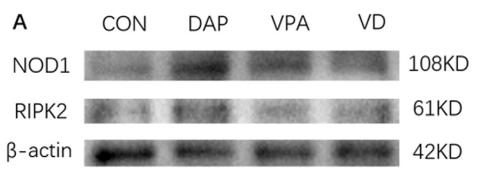Phospho-RIPK2 (Ser176) Antibody - #AF0049
| Product: | Phospho-RIPK2 (Ser176) Antibody |
| Catalog: | AF0049 |
| Description: | Rabbit polyclonal antibody to Phospho-RIPK2 (Ser176) |
| Application: | WB IHC IF/ICC |
| Cited expt.: | WB |
| Reactivity: | Human, Mouse, Rat |
| Mol.Wt.: | 70kDa; 61kD(Calculated). |
| Uniprot: | O43353 |
| RRID: | AB_2834094 |
Product Info
*The optimal dilutions should be determined by the end user. For optimal experimental results, antibody reuse is not recommended.
*Tips:
WB: For western blot detection of denatured protein samples. IHC: For immunohistochemical detection of paraffin sections (IHC-p) or frozen sections (IHC-f) of tissue samples. IF/ICC: For immunofluorescence detection of cell samples. ELISA(peptide): For ELISA detection of antigenic peptide.
Cite Format: Affinity Biosciences Cat# AF0049, RRID:AB_2834094.
Fold/Unfold
CARD 3; CARD carrying kinase; CARD containing ICE associated kinase; CARD containing IL 1 beta ICE kinase; CARD containing IL1 beta ICE kinase; CARD containing interleukin 1 beta converting enzyme (ICE) associated kinase; CARD containing interleukin 1 beta converting enzyme associated kinase; CARD-containing IL-1 beta ICE-kinase; CARD-containing interleukin-1 beta-converting enzyme-associated kinase; CARD3; CARDIAK; CCK; CLARP kinase; GIG 30; GIG30; Growth inhibiting gene 30; Receptor interacting protein (RIP) like interacting caspase like apoptosis regulatory protein (CLARP) kinase; Receptor interacting protein 2; Receptor interacting serine threonine kinase 2; Receptor interacting serine/threonine protein kinase 2; Receptor-interacting protein 2; Receptor-interacting serine/threonine-protein kinase 2; RICK; RIP 2; RIP like interacting CLARP kinase; RIP-2; RIP-like-interacting CLARP kinase; RIPK 2; Ripk2; RIPK2_HUMAN; TNFRSF; Tyrosine-protein kinase RIPK2; UNQ277/PRO314/PRO34092;
Immunogens
A synthesized peptide derived from human RIPK2 around the phosphorylation site of Ser176.
Detected in heart, brain, placenta, lung, peripheral blood leukocytes, spleen, kidney, testis, prostate, pancreas and lymph node.
- O43353 RIPK2_HUMAN:
- Protein BLAST With
- NCBI/
- ExPASy/
- Uniprot
MNGEAICSALPTIPYHKLADLRYLSRGASGTVSSARHADWRVQVAVKHLHIHTPLLDSERKDVLREAEILHKARFSYILPILGICNEPEFLGIVTEYMPNGSLNELLHRKTEYPDVAWPLRFRILHEIALGVNYLHNMTPPLLHHDLKTQNILLDNEFHVKIADFGLSKWRMMSLSQSRSSKSAPEGGTIIYMPPENYEPGQKSRASIKHDIYSYAVITWEVLSRKQPFEDVTNPLQIMYSVSQGHRPVINEESLPYDIPHRARMISLIESGWAQNPDERPSFLKCLIELEPVLRTFEEITFLEAVIQLKKTKLQSVSSAIHLCDKKKMELSLNIPVNHGPQEESCGSSQLHENSGSPETSRSLPAPQDNDFLSRKAQDCYFMKLHHCPGNHSWDSTISGSQRAAFCDHKTTPCSSAIINPLSTAGNSERLQPGIAQQWIQSKREDIVNQMTEACLNQSLDALLSRDLIMKEDYELVSTKPTRTSKVRQLLDTTDIQGEEFAKVIVQKLKDNKQMGLQPYPEILVVSRSPSLNLLQNKSM
Research Backgrounds
Serine/threonine/tyrosine kinase that plays an essential role in modulation of innate and adaptive immune responses. Upon stimulation by bacterial peptidoglycans, NOD1 and NOD2 are activated, oligomerize and recruit RIPK2 through CARD-CARD domains. Contributes to the tyrosine phosphorylation of the guanine exchange factor ARHGEF2 through Src tyrosine kinase leading to NF-kappaB activation by NOD2. Once recruited, RIPK2 autophosphorylates and undergoes 'Lys-63'-linked polyubiquitination by E3 ubiquitin ligases XIAP, BIRC2 and BIRC3. The polyubiquitinated protein mediates the recruitment of MAP3K7/TAK1 to IKBKG/NEMO and induces 'Lys-63'-linked polyubiquitination of IKBKG/NEMO and subsequent activation of IKBKB/IKKB. In turn, NF-kappa-B is released from NF-kappa-B inhibitors and translocates into the nucleus where it activates the transcription of hundreds of genes involved in immune response, growth control, or protection against apoptosis. Plays also a role during engagement of the T-cell receptor (TCR) in promoting BCL10 phosphorylation and subsequent NF-kappa-B activation. Plays a role in the inactivation of RHOA in response to NGFR signaling.
Autophosphorylated. Autophosphorylation at Tyr-474 is necessary for effective NOD2 signaling. Phosphorylated. Phosphorylation at Tyr-381 by Src kinase CSK occurs in a ARHGEF2-dependent manner and is required for NOD2-dependent innate immune activation.
Ubiquitinated on Lys-209; undergoes 'Lys-63'-linked polyubiquitination catalyzed by ITCH. Polyubiquitinated with 'Lys-48' and 'Lys-63'-linked chains by BIRC2/c-IAP1 and BIRC3/c-IAP2, leading to activation of NF-kappa-B. Also undergoes 'Met-1'-linked polyubiquitination; the head-to-tail linear polyubiquitination is mediated by the LUBAC complex in response to NOD2 stimulation. Linear polyubiquitination is restricted by FAM105B/otulin, probably to limit NOD2-dependent proinflammatory signaling activation of NF-kappa-B.
Cytoplasm.
Detected in heart, brain, placenta, lung, peripheral blood leukocytes, spleen, kidney, testis, prostate, pancreas and lymph node.
Contains an N-terminal kinase domain and a C-terminal caspase activation and recruitment domain (CARD) that mediates the recruitment of CARD-containing proteins.
Belongs to the protein kinase superfamily. TKL Ser/Thr protein kinase family.
Research Fields
· Human Diseases > Infectious diseases: Bacterial > Shigellosis.
· Human Diseases > Infectious diseases: Bacterial > Tuberculosis.
· Organismal Systems > Immune system > NOD-like receptor signaling pathway. (View pathway)
· Organismal Systems > Nervous system > Neurotrophin signaling pathway. (View pathway)
References
Application: WB Species: bovine Sample: BMECs
Application: WB Species: Rat Sample: NR8383 cells
Restrictive clause
Affinity Biosciences tests all products strictly. Citations are provided as a resource for additional applications that have not been validated by Affinity Biosciences. Please choose the appropriate format for each application and consult Materials and Methods sections for additional details about the use of any product in these publications.
For Research Use Only.
Not for use in diagnostic or therapeutic procedures. Not for resale. Not for distribution without written consent. Affinity Biosciences will not be held responsible for patent infringement or other violations that may occur with the use of our products. Affinity Biosciences, Affinity Biosciences Logo and all other trademarks are the property of Affinity Biosciences LTD.







